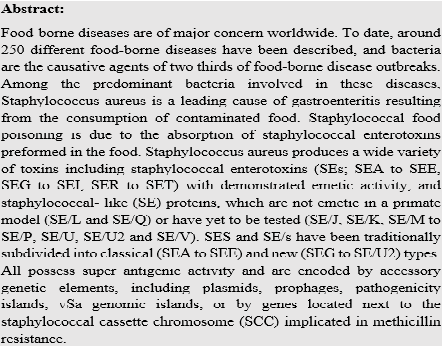Characterization of Staphylococcal Food Poisoning
Abstract
Food-borne diseases are of major concern worldwide. To date, around 250 different food-borne diseases have been described, and bacteria are the causative agents of two thirds of food-borne disease outbreaks. Among the predominant bacteria involved in these diseases, Staphylococcus aureus is a leading cause of gastroenteritis resulting from the consumption of contaminated food. Staphylococcal food poisoning is due to the absorption of staphylococcal enterotoxins preformed in the food. Staphylococcus aureus produces a wide variety of toxins including staphylococcal enterotoxins (SEs; SEA to SEE, SEG to SEI, SER to SET) with demonstrated emetic activity, and staphylococcal- like (SE) proteins, which are not emetic in a primate model (SE/L and SE/Q) or have yet to be tested (SE/J, SE/K, SE/M to SE/P, SE/U, SE/U2 and SE/V). SES and SE/s have been traditionally subdivided into classical (SEA to SEE) and new (SEG to SE/U2) types. All possess superantigenic activity and are encoded by accessory genetic elements, including plasmids, prophages, pathogenicity islands, vSa genomic islands, or by genes located next to the staphylococcal cassette chromosome (SCC) implicated in methicillin resistance.
Full text article
References
Mead P S, Slutsker L, Dietz V, McCaig LF, Breese JF, Shapro C, Griffin P G, Tauxe R V. (1999). Food-related illness and death in the United States. Emerging Infectious Diseases. 5; 607-841.
Painter J A, Hoekstra R M. Ayers T, Tauxe R. V, Braden C R, Angulo F J, Griffin P M (2013). Attribution of foodborne illnesses, hospitalizations, and deaths to food commodities by using outbreak data, United States, 1998-2008. Emerging Infectious Diseases. 19; 407-415.
Slifko T R, Smith H, Rose J B. (2000). Emerging parasite zoonoses associated with water and food. International Journal of Parasitology. 30; 1379-93.
Syne S, Ramsubhag A. Adesiyun A. (2013): Microbiological hazard analysis of ready-to-eat meats processed at a food plant in Trinidad, West Indies. Infectious Ecology and Epidemiology. 3; 20450.
Pal M. (2001). Epidemiology of staphylococcal food poisoning. Beverage and Food World. 28; 11-13.
Pal M. (2007). Zoonoses.2nd Edition, Satyam Publishers, Jaipur, India. 138-139.
Dinges M.M., Orwin P.M., Schlievert P.M. Exotoxins of Staphylococcus aureus. Clin. Microbiol. Rev. 2000;13:16–34.
Le Loir Y., Baron F., Gautier M. Staphylococcus aureus and food poisoning. Genet. Mol. Res. 2003;2:63–76.
Balaban N., Rasooly A. Staphylococcal enterotoxins. Int. J. Food Microbiol. 2000;61:1–10.
Murray R.J. Recognition and management of Staphylococcus aureus toxin-mediated disease. Intern. Med. J. 2005;2:S106–S119.
Tranter H.S. Foodborne staphylococcal illness. Lancet. 1990;336:1044–1046.
Kluytmans J.A.J.W., Wertheim H.F.L. Nasal carriage of Staphylococcus aureus and prevention of nosocomial infections. Infection. 2005;33:3–8.
Stewart G.C. Staphylococcus aureus. In: Fratamico P.M., Bhunia A.K., Smith J.L., editors. Foodborne pathogens: Microbiology and Molecular Biology. Caister Academic Press; Norfolk, UK: 2005. pp. 273–284.
Petersson K., Pettersson H., Skartved N.J., Walse B., Forsberg G. Staphylococcal enterotoxin H induces V alpha-specific expansion of T cells. J. Immunol. 2003;170:4148–4154
Thomas D.Y., Jarraud S., Lemercier B., Cozon G., Echasserieau K., Etienne J., Gougeon M.L., Lina G., Vandenesch F. Staphylocccal enterotoxin-like toxins U2 and V, two new staphylococcal superantigens arising from recombination within the enterotoxin gene cluster. Infect. Immun. 2006;74:4724–4734.
Wieneke A.A., Roberts D., Gilbert R.J. Staphylococcal food poisoning in the United Kingdom, 1969–90. Epidemiol. Infect. 1993;110:519–531.
Kérouanton A., Hennekinne J.A., Letertre C., Petit L., Chesneau O., Brisabois A., De Buyser M.L. Characterization of Staphylococcus aureus strains associated with food poisoning outbreaks in France. Int. J. Food Microbiol. 2007;115:369–375.
Schmid D., Fretz R., Winter P., Mann M., Höger G., Stöger A., Ruppitsch W., Ladstätter J., Mayer N., de Martin A., Allerberger F. Outbreak of staphylococcal food intoxication after consumption of pasteurized milk products, June 2007, Austria. Wien. Klin. Wochenschr. 2009;121:125–131. .
Casman E.P. Staphylococal enterotoxin. Ann. N.Y. Acad. Sci. 1965;128:124–131.
Veras J.F., do Carmo L.S., Tong L.C., Shupp J.W., Cummings C., Dos Santos D.A., Cerqueira M.M., Cantini A., Nicoli J.R., Jett M. A study of the enterotoxigenicity of coagulase-negative and coagulase-positive staphylococcal isolates from food poisoning outbreaks in Minas Gerais, Brazil. Int. J. Infect. Dis. 2008;12:410–415.
Cha J.O., Lee J.K., Jung Y.H., Yoo J.I., Park Y.K., Kim B.S., Lee Y.S. Molecular analysis of Staphylococcus aureus isolates associated with staphylococcal food poisoning in South Korea. J. Appl. Microbiol. 2006;101:864–871.
Shimizu A., Fujita M., Igarashi H., Takagi M., Nagase N., Sasaki A., Kawano J. Characterization of Staphylococcus aureus coagulase type VII isolates from staphylococcal food poisoning outbreaks (1980–1995) in Tokyo, Japan, by pulsed field gel electrophoresis. J. Clin. Microbiol. 2000;38:3746–3749.
Authors

This work is licensed under a Creative Commons Attribution 4.0 International License.
